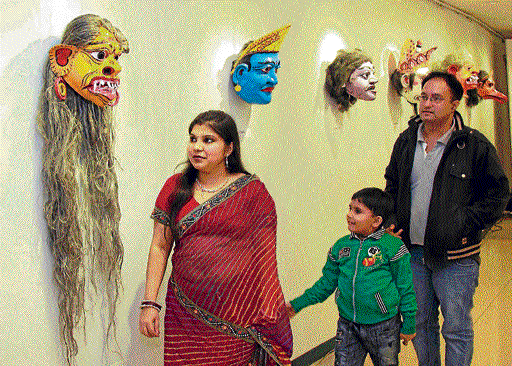
ICCR presented an unique exhibition of traditional bamboo Masks of Assam by artists from Mumbai-based Pratishruti Foundation as part of Horizon Series, which aims at promoting the culture of Assam.
Masks, also known as mukhas, are said to be at the base of Assamese culture and tradition. They are worn mostly during theatre and dance dramas revolving around the Assamese tribal myths and folktales. Since ages, these masks have been at the centre of each and every cultural event in the state. The traditional Assamese masks are made from a variety of material, ranging from terracotta and bamboo to wood, pith and metals. They usually represent the local gods and goddesses and have characters from ancient epics like Mahabharata.
Traditional mask-making begun by Shrimant Shankardev divides these masks into three types - Cho mask, Lotokoi mask, Mukh mask. Cho is the biggest in size and usually made up of two parts - head and body. Lotokoi is a smaller version of the Cho mask and the Mukh covers only the face. In Assam, the masks made in Majuli island are very popular. The masks are made of clay, bamboo or cloth and are light in weight, which makes them unique.
Pratiksha Suresh, founder of Pratishruti Foundation says, “The whole objective behind this exhibition is to promote the culture and art of Assam and these masks are part of the series.”
The mask-making industry is a major means of livelihood for the rural population of Assam. The skills required to make these masks are generally passed down from one generation to the next under the guidance of a teacher. “In Assam, mask-making is an extensive process, involving splitting of bamboo strips to form the frame, pasting layers of clothes dipped in clay and finally drying them under the sun. The normal time required for completing a single mask is around 10-15 days,” adds Pratiksha.
Usually earth or vegetable colours are used to give the final touches to the traditional Assamese masks, with the most common colours being red and yellow. Nowadays, however, chemical dyes are also being used to give better effects.
Recent times have seen a growth in the production of these masks, as many modern day homes use them as decorative items in their drawing rooms. This has greatly increased the employment opportunities of the mask-makers, thus improving their standard of living.